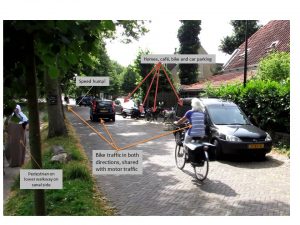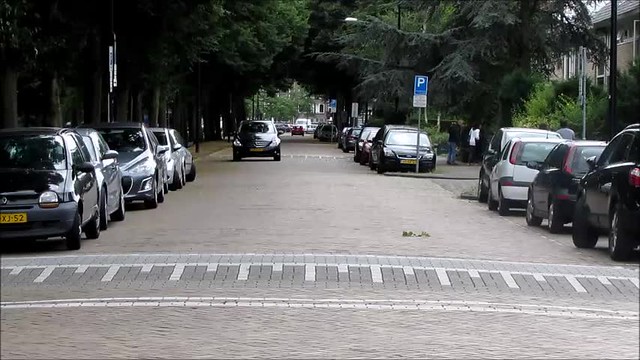The speed humps of Van Vredenburchweg
1.The main objective of the speed hump:
The point of the speed humps is to slow motorists. Pedestrians are unaffected, being on a separated walkway. Bikes are not compelled to slow down. Speed humps are usually applied to help naturally enforce 30 kph areas. Usually a series of speed humps is used, to prevent acceleration and speeding after passing over a speed hump.
2. The context of Van Vredenburchweg:
This section of Van Vredenburchweg is a side street of a busy through road, Huis de Landelaan. On either side, there is a lot of green space. This section of the street holds a number of destinations. There is a parking lot, a cafe, a recreational walking path, and residential housing on the north side. At the end of this small segment of Van Vredenburchweg, there is a side residential street, and a permeable barrier, allowing mopeds, bikes, and pedestrians to pass to a mixed use recreational road, passing by various walking paths, and a small petting zoo. On the south side of the street there is a small canal and a sidewalk. This street is also a good quiet route towards the old city center of Rijswijk for bikes and pedestrians.

3. Treatment Performance and the Principles of Sustainable Safety
- Functionality: This road is meant for access. People come to this street to access these various destinations, as mentioned above, by various forms of transportation, all sharing the entirety of the street, which has no means of separation between motor vehicles and bikes.
- Homogeneity: Because there are a lot of slower moving, smaller vehicles sharing this street with cars, larger vehicles such as cars or vans are expected to move at most at a speed of 30 kph. This speed limit is not enforced by signs but rather, by using speed humps. Because the driver sees so much bike traffic as well as speed humps, they instinctually drive slower to avoid hazards to themselves or others.
- These principles play on to the principles of Predictability and Social Forgivingness: Because of its multiple functions, the street is designed appropriately: This 160 meter stretch of shared use road has rough bricked pavement throughout, as well as 4 speed humps where motor traffic takes place, which tells the drivers to drive slowly, even when they do not explicitly see bikers or pedestrians. Because the street has a steady flow of users, drivers and other cyclists are aware of each other, and travel carefully. Motorists especially take caution because they understand that even if they don’t see a cyclists, it is possible that there will be cyclists sharing the road at any point. With the help of the speed humps, all people sharing the street are aware of each other, and accidents are more easily prevented, and if they do occur, they would not be life threatening.
4. How the treatment is appropriate for Van Vredenburchweg
Van Vredenburchweg is a very narrow and straight local street, with no center line. People of all different modes of transportation share the road, and cross often, for the destinations mentioned above, creating potential for close encounters between bikes and pedestrians and cars. Because there is a canal and sidewalk on one side, and cafes and residences on the other, it would not be an efficient use of space to use horizontal traffic calming measures, such as chicanes or crossing islands. Rather, in order to keep the road homogenous for safety, speed humps are the best option to slow down speeds.
5. How does the speed hump function to achieve speed control
Drivers are uncomfortable going quickly over rough terrain. Bricked pavement is bumpy, and uncomfortable to drive on. But speed humps are even more unpleasant, giving the driver a lurching motion, especially at higher speeds. Drivers thus slow down to avoid the discomfort. When there is a series of speed humps, cars don’t have time to reaccelerate after a speed hump before encountering the next hump, and thus maintain a consistent slow speed throughout. Repeat rapid acceleration and deceleration are also uncomfortable for the driver.
Sharper inclines and shorter humps give a bigger jolt. Speed humps are usually around half a foot tall. Usually, the length in feet of the hump is the speed that drivers should be going over the hump. For example, 14 ft humps are intended to make drivers pass over them at around 14 mph or 22 kph. This means that in between humps, cars wouldn’t have much time to reach 30 kph before reaching another speed hump, slowing them to 22 kph.
Typical speed humps are 12, 14, and 22 feet long, or 3.6, 4.3, and 6.7 meters long. The speed humps on Van Vredenburchweg specifically are around 15 feet long.
This video shows how speed humps control speed:
6. Other observations:
- Speed humps are placed strategically: one in the entrance of the street, to let the drives know right away that they should not be speeding on this street, and two in front of potential pedestrian crossings. One of these is right where a pedestrian walkway meets the street, and one is where a side residential street meets Van Vredenburchweg. At these areas, it is more likely that a pedestrian will enter the street either to walk on the street, or cross the street to get to the sidewalk on the canal side of the street.
- Because the street is so straight and wide enough for traffic in both directions (approx 4 meters), speed humps are an appropriate way to slow traffic. Chicanes would not work when there is a canal on one side and properties on the other.

